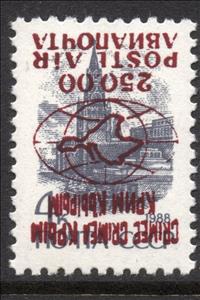Stamp: 2nd Airmail Overprints issue (Cinderellas 1993)
2nd Airmail Overprints issue (Cinderellas 1993)
01 January (Cinderellas ) within release Crimea, Ukraine goes into circulation Stamp 2nd Airmail Overprints issue face value 250 Ukrainian karbovanets
| Stamp 2nd Airmail Overprints issue in catalogues | |
|---|---|
| Colnect codes: | Col: UA-KM 1993-09/04 |
Stamp is vertical format.
Crimea RED GLOBE/MAP INVERTED overprint on USSR 4k stamp issued in 1988Also in the issue Crimea, Ukraine:
- Stamp - 2nd Emergency Overprints face value 50;
- Stamp - First Emergency overprints face value 15;
- Stamp - Airmail Issue face value 450;
- Stamp - 2nd Emergency Overprints face value 27;
- Stamp - 2nd Emergency Overprints face value 28;
- Stamp - 2nd Emergency Overprints face value 250;
- Stamp - Airmail Issue face value 50;
- Stamp - 2nd Emergency Overprints face value 300;
- Stamp - 2nd Emergency Overprints face value 300;
- Stamp - First Emergency overprints face value 3;
- Stamp - First Emergency overprints face value 15;
- Stamp - 2nd Emergency Overprints face value 27;
- Stamp - 2nd Emergency Overprints face value 50;
- Stamp - 2nd Emergency Overprints face value 27;
- Stamp - First Emergency overprints face value 70;
- Stamp - Airmail Issue face value 80;
- Stamp - 2nd Emergency Overprints face value 100;
- Stamp - 2nd Emergency Overprints face value 250;
- Stamp - 2nd Emergency Overprints face value 300;
- Stamp - 2nd Emergency Overprints face value 49.95;
- Stamp - Airmail Issue face value 150;
- Stamp - First Emergency overprints face value 70;
- Stamp - First Emergency overprints face value 3;
- Stamp - 2nd Emergency Overprints face value 27;
- Stamp - 2nd Airmail Overprints issue face value 250;
- Stamp - 2nd Airmail Overprints issue face value 500;
- Stamp - 2nd Airmail Overprints issue face value 250;
- Stamp - 2nd Airmail Overprints issue face value 500;
- Stamp - 2nd Airmail Overprints issue face value 500;
- Stamp - 2nd Airmail Overprints issue face value 250;
- Stamp - 2nd Airmail Overprints issue face value 250;
- Stamp - 2nd Airmail Overprints issue face value 500;
- Stamp - 2nd Airmail Overprints issue face value 500;
- Stamp - 2nd Airmail Overprints issue face value 500;
Stamp 2nd Airmail Overprints issue it reflects the thematic directions:
A globe is a spherical model of Earth, of some other celestial body, or of the celestial sphere. Globes serve purposes similar to maps, but, unlike maps, they do not distort the surface that they portray except to scale it down. A model globe of Earth is called a terrestrial globe. A model globe of the celestial sphere is called a celestial globe
A map is a symbolic depiction emphasizing relationships between elements of some space, such as objects, regions, or themes. Many maps are static, fixed to paper or some other durable medium, while others are dynamic or interactive. Although most commonly used to depict geography, maps may represent any space, real or imagined, without regard to context or scale, such as in brain mapping, DNA mapping, or computer network topology mapping. The space being mapped may be two dimensional, such as the surface of the earth, three dimensional, such as the interior of the earth, or even more abstract spaces of any dimension, such as arise in modeling phenomena having many independent variables. Although the earliest maps known are of the heavens, geographic maps of territory have a very long tradition and exist from ancient times. The word "map" comes from the medieval Latin Mappa mundi, wherein mappa meant napkin or cloth and mundi the world. Thus, "map" became the shortened term referring to a two-dimensional representation of the surface of the world.
A star is a luminous spheroid of plasma held together by self-gravity. The nearest star to Earth is the Sun. Many other stars are visible to the naked eye at night; their immense distances from Earth make them appear as fixed points of light. The most prominent stars have been categorised into constellations and asterisms, and many of the brightest stars have proper names. Astronomers have assembled star catalogues that identify the known stars and provide standardized stellar designations. The observable universe contains an estimated 1022 to 1024 stars. Only about 4,000 of these stars are visible to the naked eye—all within the Milky Way galaxy.
The United Nations Educational, Scientific and Cultural Organization (UNESCO; pronounced /juːˈnɛskoʊ/) is a specialized agency of the United Nations (UN) with the aim of promoting world peace and security through international cooperation in education, arts, sciences and culture. It has 194 member states and 12 associate members,as well as partners in the non-governmental, intergovernmental and private sector. Headquartered in Paris, France, UNESCO has 53 regional field offices and 199 national commissions




